Argentina is expected to win every tournament they play regardless of the squad, situation or rivals and this year’s Copa América won’t be any different. For a country that hasn’t won anything since 1993, it always seems like the next trophy will be the one and they’ll face massive pressure to raise the trophy at home.
Despite being his first head coach job in senior football, Lionel Scaloni seems to have found the much-needed stability to lead a national team with expectations as high as Argentinians. His time as an assistant coach to Jorge Sampaoli was enough for the Argentinian federation to trust him and he’s a fresh face that’s expected to translate all his playing experience into good results with a new generation of footballers. So far, he has averaged 2.04 points per game in his 25 games in charge since 2018, much better than his two immediate predecessors Jorge Sampaoli (1.67) and Edgardo Bauza (1.38).
Argentina will face Uruguay and Chile, two of the favourites for the title, and also Bolivia and Paraguay for one of the four spots in the quarter-finals. Going through the group stage should be easy for them.
In this tactical analysis, we’ll have a look at Argentina’s tactics, playing style and best players to predict how they could do in the tournament. As one of the last chances Messi will have to raise a trophy for his country and hosting the cup, it will be an especially interesting one for Argentina.
THE SQUAD
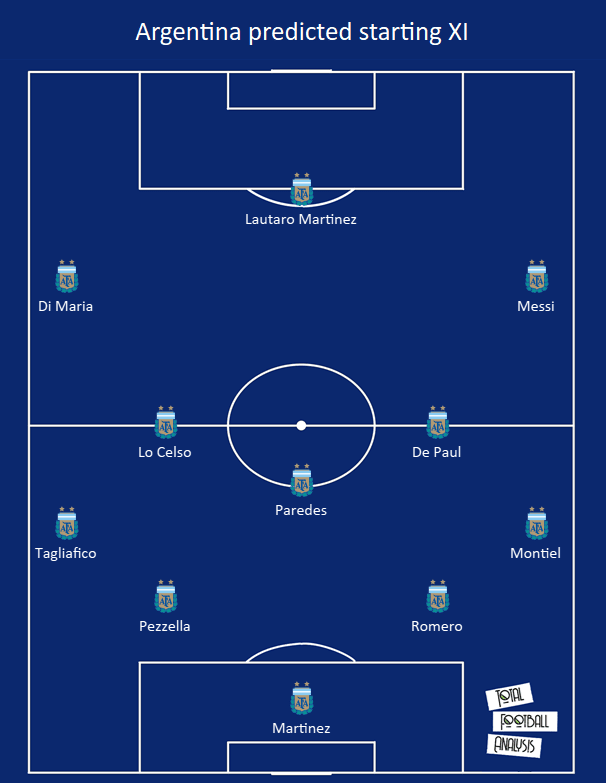
With plenty of options in every position, choosing a starting XI for Argentina won’t be an easy task for Scaloni. It seems clear that he’ll use a 4-3-3 or 4-4-2 depending on where we want to locate Messi and the phase of the game.
In goal, Franco Armani has been the preferred choice recently. However, River Plate’s goalkeeper is already 34 and has missed some games recently due to COVID so it seems reasonable that Scaloni will go for someone playing at a higher level who could also be the future number one. Both Juan Musso, who plays for Udinese in Serie A, and Emiliano Martínez, Aston Villa’s goalkeeper in the EPL, are the best options and despite not having any caps yet, we expect Martínez to start in the Copa América.
In defence, the right-back spot seems clear, with Gonzalo Montiel having started the last four games and not having a lot of competence in the position. The River Plate defender has already been targeted by big clubs in Europe and he’ll have the chance to add more caps to the eight he already has.
On the left, Scaloni has tried different options and has very good depth. Sevilla’s Marcos Acuña and Ajax’s Nicolás Tagliafico are the two main contenders. Both have 28 caps to their names and have had successful seasons at their clubs. We’ve chosen Acuña as the starting player because of his excellent work rate and power going forward and also because he’s playing at a higher level. A third option could be Nico González, who’s normally a forward but has been used as a left-back by Scaloni. However, he has been injured for most of the last months and despite having scored six goals in just 633 minutes in the Bundesliga, he could struggle to make the list.
The centre-back position is also very unclear. The usual partners have been Nicolás Otamendi, now playing for Benfica and captaining them, and Lucas Martínez Quarta, who has had a decent first season at Fiorentina but isn’t an automatic starter there.
Scaloni could opt for keeping his usual lineup or trying with players who are playing at a higher level and having better seasons. If he decides to change, the Serie A partnership of Germán Pezzella (Fiorentina) and Cristian Romero (Atalanta) looks like the best choice. Both of them have had excellent seasons at their clubs and offer a very good mix of experience and youth. Even if Romero doesn’t have any cap to his name yet and substituting Otamendi who has been capped 74 times is a big step, he still seems the best option going forward.
In midfield, Leandro Paredes, Giovani Lo Celso and Rodrigo De Paul are the expected starting trio. Leverkusen’s Exequiel Palacios has had his chances too in recent matches but he’s still 22, hasn’t played a lot this season after picking a back injury with Argentina in November 2020 and doesn’t have as much international experience as the other three.
In attack, Lionel Messi and Lautaro Martínez will be starting, leaving just one free spot in the lineup. The list of candidates for that position is very long but Ángel Di María, who has had a great season at PSG, is the best option overall. With over 100 caps and over 40 goal contributions for Argentina, the winger could adapt to both wings and provide the quality and work rate Scaloni asks from his players.
Other options are Lucas Ocampos, who fits very well with his energetic style and has been used frequently; Lazio’s Joaquín Correa, a quality player who has enjoyed a great season; Ángel Correa, who can play from the left or in more central positions and playing for Atlético Madrid he has developed the intensity he needs to compete in Argentina. And if Scaloini chooses to play two strikers, Sergio Agüero is a fantastic option, Lucas Alario has also responded well when he has had the chance and Mauro Icardi remains a top-class striker even if he’s not having his best year at PSG. And we still haven’t mentioned Papu Gómez, Emi Buendía, Gio Simeone, Paulo Dybala or Eric Lamela, who could also get minutes in different scenarios.
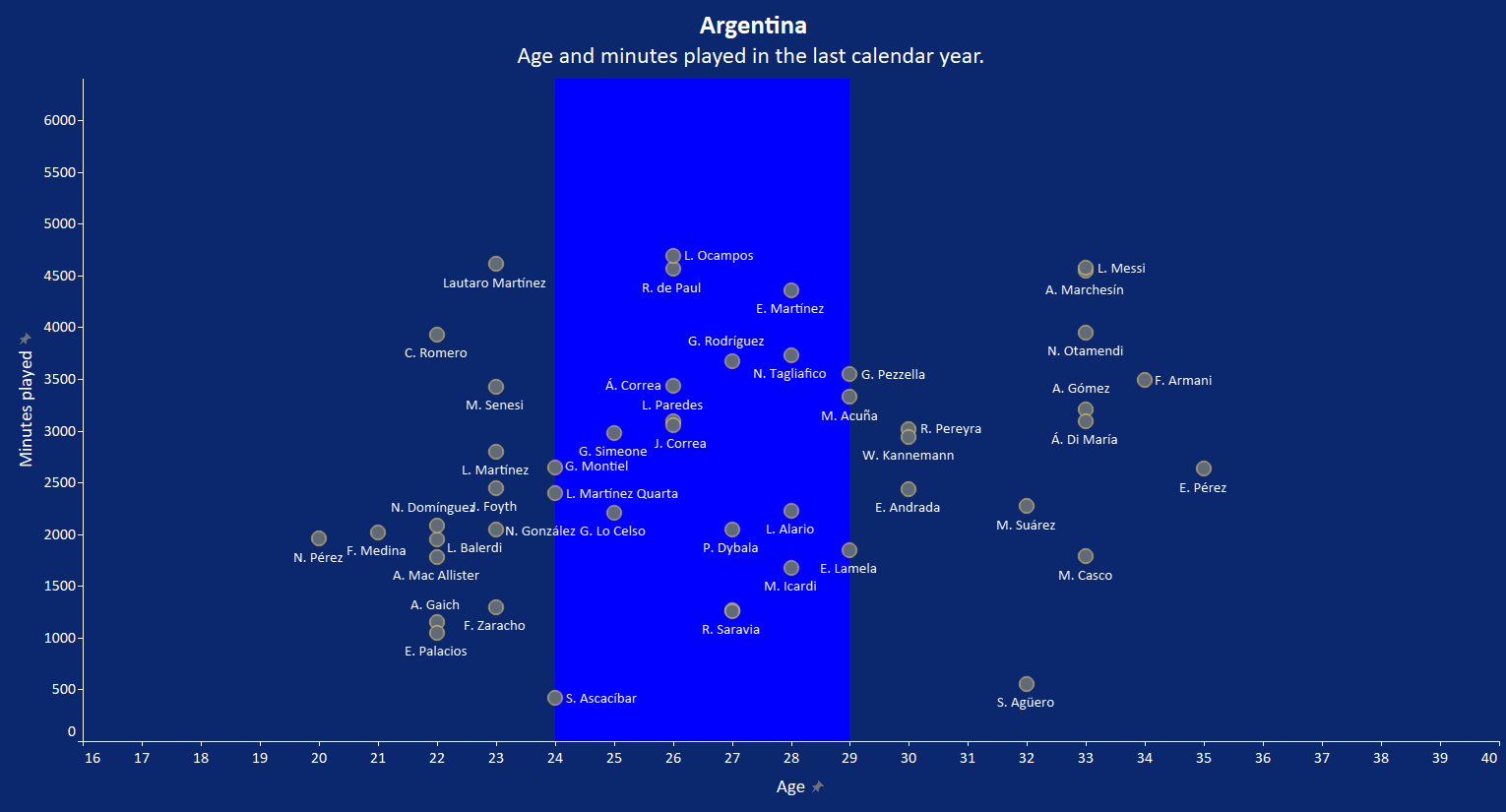
Regarding age, Argentina has a very nice balance of young and experienced players who are playing consistently at a high level.
With very experienced players like Messi and Di María still at a great level and Otamendi and Armani (if they play) leading big teams even if not in a top-5 league, the leadership is assured for the Argentinian national team.
When it comes to players at their peak, Pezzella, Acuña, Emiliano Martínez, Taglaifico, De Paul, Ocampos or Paredes are regular starters at the highest level. Other players who are either stars at a slightly lower level or not starting every game at the top level are Lo Celso, Montiel, or Martínez Quarta. Some peak players aren’t having a great season but they’re still expected to make an impact if needed like Dybala, Icardi or Lamela.
Some players are still very young and already playing for top teams who can lead the national team in the following years. Lautaro Martínez, a star for Inter in the Serie Al or Cristian Romero, a regular starter for a very good Atalanta side, are the clearest examples. Other interesting young players who may have opportunities but aren’t as established are Exequiel Palacios, Facundo Medina or Marcos Senesi.
Surprises are usual in South American football and it shouldn’t be a shock if Scaloni chooses to play some unusual choices from a European point of view. Players like Matías Zaracho (23, Atlético Mineiro), Walter Kannemann (30, Grêmio) or Enzo Pérez (35, River Plate) could have a role in the squad as they’re more used to the South American football and have a different set of experiences that could help the time in specific moments.
Argentina’s 23-man predicted squad is the following:
Goalkeepers
Franco Armani
Emiliano Martínez
Juan Musso
Defenders
Marcos Acuña
Juan Foyth
Lucas Martínez Quarta
Gonzalo Montiel
Nicolás Otamendi
Germán Pezzella
Cristian Romero
Nicolás Tagliafico
Midfielders
Rodrigo De Paul
Nicolás González
Giovani Lo Celso
Lucas Ocampos
Exequiel Palacios
Leandro Paredes
Guido Rodríguez
Forwards
Sergio Agüero
Ángel Correa
Ángel Di María
Lautaro Martínez
Lionel Messi (c)
ATTACKING PHASE
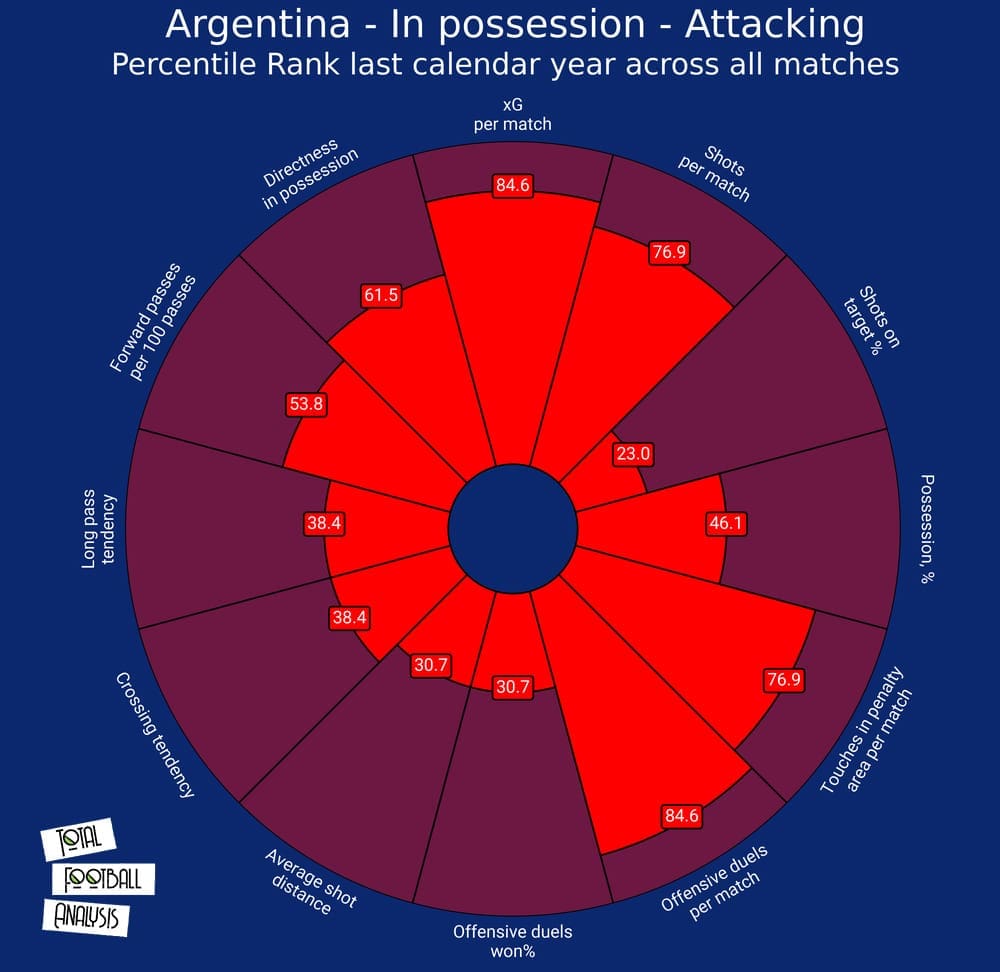
As one of the big teams in the continent, Argentina tends to dominate possession, both because of their playing style and rivals usually sitting deep and looking to defend against them. Playing at home in this edition of the Copa América, they’re considered the favourites and will have to step up to the challenge.
However, Scaloni’s team doesn’t look to have the ball at all cost and is a direct team in attack, trying to get the ball forward quickly. If we have a look at Argentina’s offensive stats, they’re a team that shoots a lot (more than 76.9% of the teams in the competition) and from good positions (one of the highest xG per match and lowest average shot distance). It’s especially interesting how they rank very highly in touches in the box per 90 but below average in possession. This means that despite being a team capable of dominating, they still look to get the ball into the box quickly but usually using low passes as shown by their very low aerial duels per 90.
Scaloni has a preference for technically solid players in all lines but also demands dynamism, especially from his full-backs and central midfielders. De Paul and Lo Celso are the ones expected to play in front of Paredes in midfield and both of them combine good running capacity with quality on the ball. When looking at the starting players in general, they’re all aggressive in attack and look to get forward frequently and beat rivals, which explains why Argentina gets involved in more offensive duels than 84.6% of the teams in the tournament.
When looking at Argentina’s positioning in attack, Paredes stays in front of the centre-backs, helping in the buildup and recycling possession while his midfield partners have a much more dynamic role, joining the attack, appearing on both wings and making runs in behind. The formation looks like a very fluid 4-3-3 as Messi doesn’t have a fixed position and Scaloni encourages a lot of movement.
Messi’s position determines how the players around him move. The FC Barcelona star has complete freedom to come deep, move centrally or wait near the box so the rest of the team has to adapt and occupy the spaces he leaves. The right central midfielder (usually De Paul) and the right-back are key in this as they need to provide the width and depth Messi needs on the right side of the pitch.
Upfront, Lautaro Martínez is expected to be Messi’s main partner. The Inter striker has a role that demands a very high work rate in his off-the-ball movements. He’ll run in behind, come deep to play with his back to the goal and open up spaces for Messi to play comfortably around the edge of the box while also getting into good positions into the box to be a scoring threat.
A very frequent pattern of play of Argentina in attack is playing the ball to the wings, where they can overload with the central midfielder, the winger and the full-back. They have a good organization so there’s always someone providing width and creating space for the other players to make runs in behind through the half-spaces. The full-backs don’t always overlap and can also attack through the centre if there’s a winger providing width, becoming an unpredictable weapon for the Argentinian team.
The next example shows exactly that. When the ball reaches the right side, the right-back gets forward, attracting the rival full-back and creating space for the central midfielder to also run forward between the full-back and the centre-back. With quality passers like the ones in the Argentinian squad, these movements provide very good options to get forward.
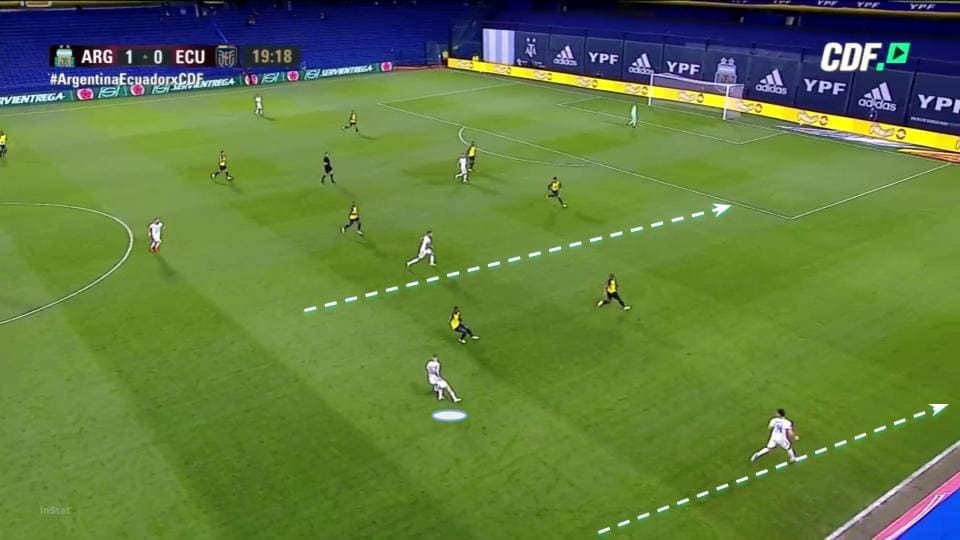
In general, Argentina is a dynamic team in attack, knowing that Messi will always create things for himself or for his teammates if there’s movement and space around him. This dynamism is one of the reasons why some exceptional players may not be granted a starting position in favour of those who fit better this style even if they aren’t as good overall.
When Argentina faces a well-organized low block and can find passes to break it, it’s Messi or one of the central midfielders who step out of that block and look to receive wide and with some space to play. When this happens, it’s crucial that the players in front of the ball-possessor still keep their running as that’s how spaces will appear.
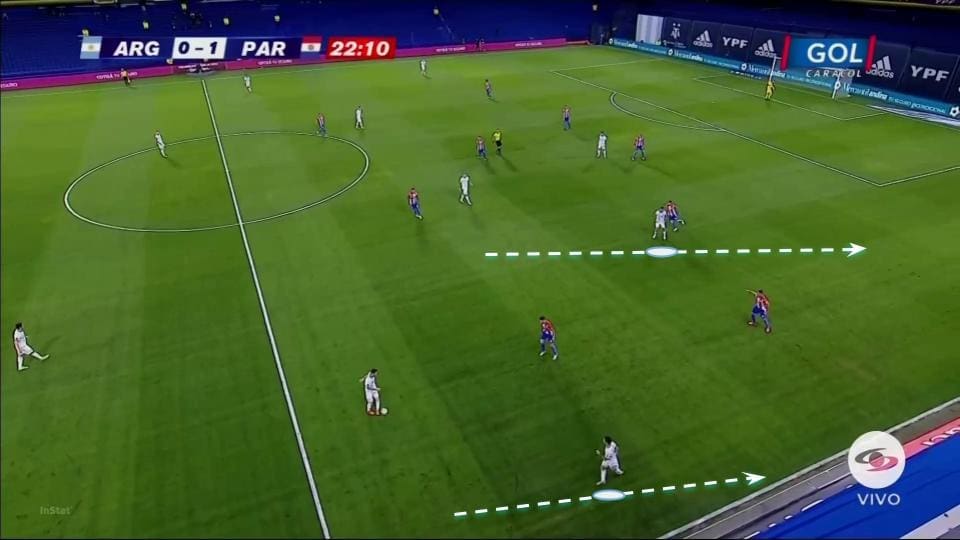
In the previous picture, there are two important details to note. First, Messi drops deep and wide to get the ball outside the rival defensive block. When he does this, the right-back Montiel provides width and De Paul gets forward and tries to provide depth on the right side, balancing Messi’s movement.
DEFENSIVE PHASE
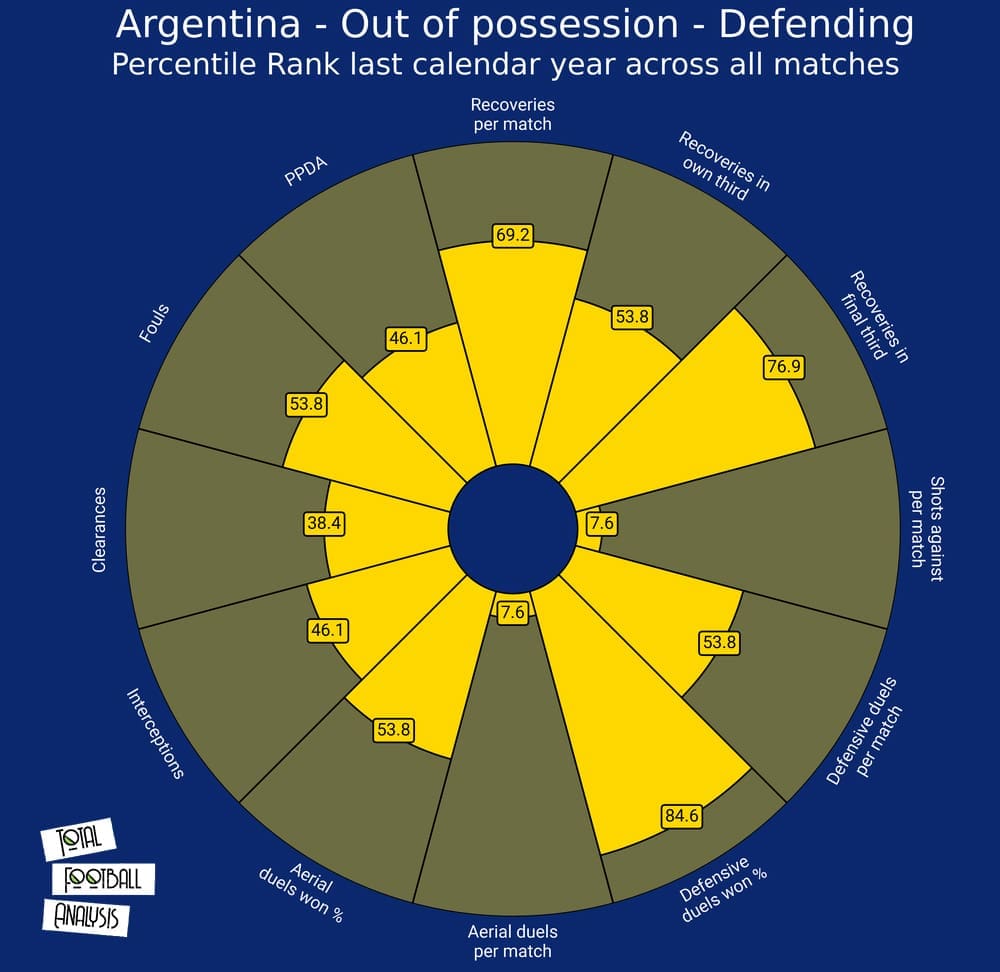
In defence, Argentina uses a clear 4-4-2 with Messi and the striker upfront, the right central midfielder covering the right-wing and Paredes and the left central midfielder in the middle.
With just below average PPDA (passes per defensive action), we can’t say Argentina is a team that uses an intense press but they don’t sit back either. They usually use a high block but don’t press the defensive line, inviting the rivals to play from the back and keeping a compact block to force them into mistakes. This has proven to be a very effective strategy and Argentina are one of the teams with the most recoveries in the final third.
The next screenshot shows us Argentina’s typical shape when pressing, with a well-defined 4-4-2 and a high block.
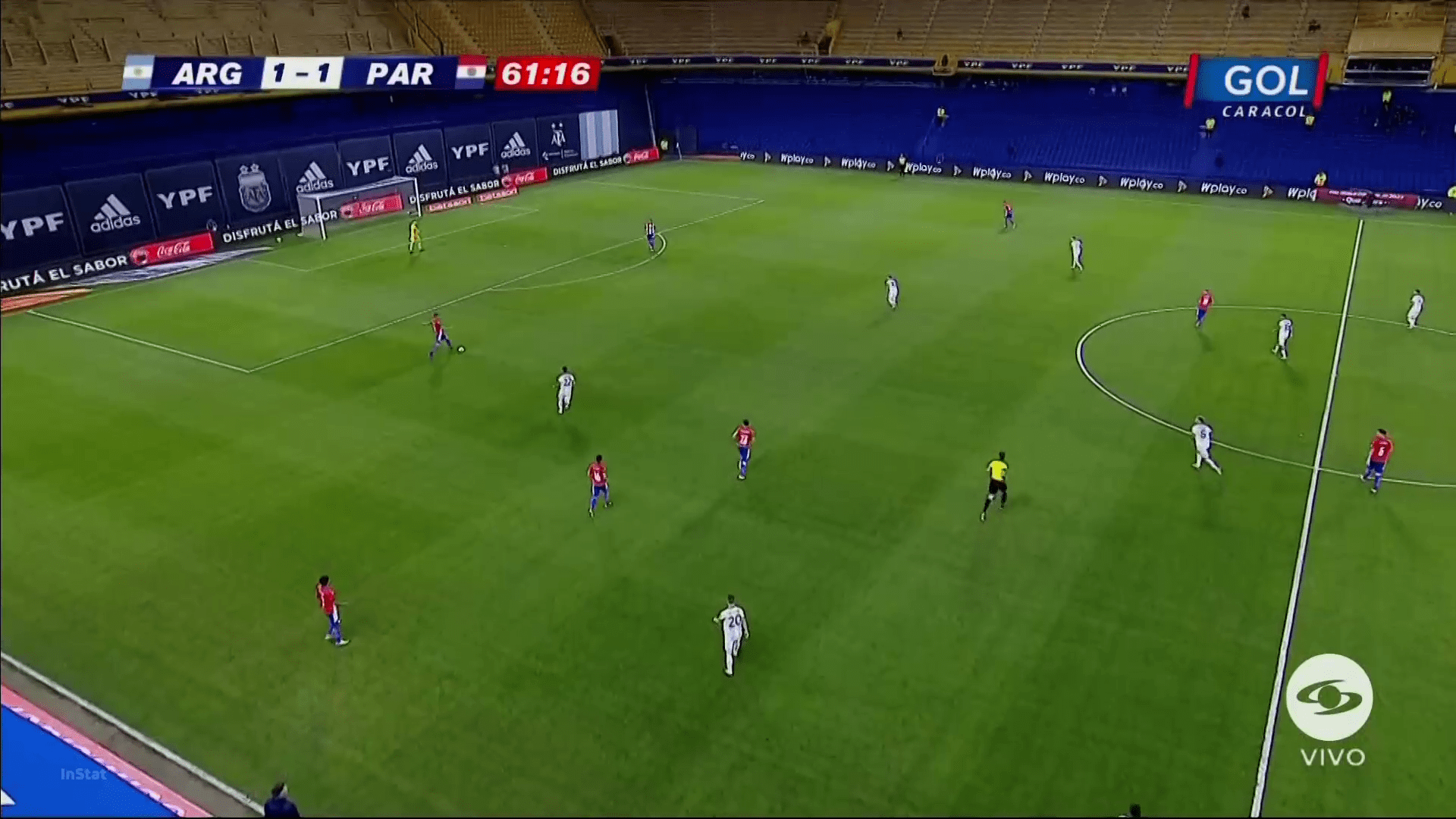
But Argentina also has a good share of recoveries in their own half so they don’t mind defending deeper if needed. They’re excellent at winning defensive duels, with solid midfield and defensive lines. If the rivals don’t fall into the trap of taking risks in the buildup, Argentina’s centre-backs are aggressive to anticipate and win duels so it’s very difficult to hold the ball against them or beat them with direct passes.
As one of the teams with the fewest conceded shots, Argentina’s defensive tactics have been working very well. Their adaptability is another key aspect of this as they can also defend in a mid-block if the rival takes control of possession and manages to build from the back.
However, there are two issues Argentina can face in defence. First, Messi could be targeted in the build-up as he’s not very aggressive and will usually let the rivals play around him. The team needs to be close to him so rivals don’t find space to play and launch quick direct attacks, requiring extra defensive work from the players on that side of the pitch.
In the picture below, we see how Messi just stands and leaves space for the rival defender to step out with the ball and launch a direct pass in behind the high defensive line.
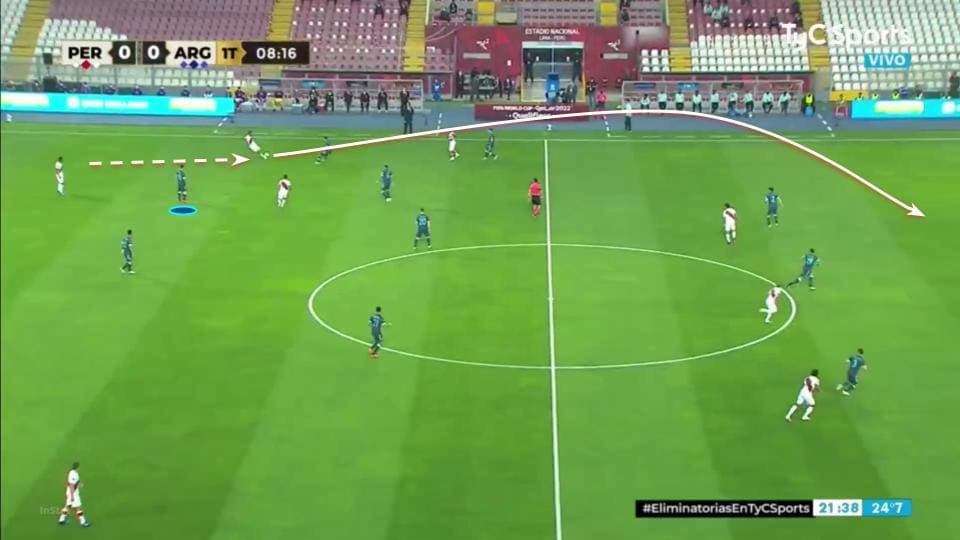
The second issue in Argentina’s defensive tactics is Paredes positioning. When he’s in front of the centre-backs he’s fantastic, covering the area very efficiently. He’s an excellent tackler and a great presence to have to protect the defensive line. But if he’s forced to leave that position to press high or defend the wings, then a lot of spaces appear in central areas and the rivals can get into dangerous positions are¡und the edge of the box. With both Messi and Lautaro staying high, there’s a lack of central players in some phases of the game and it requires a lot of effort from the wing players or from Paredes’ midfield partner in defence to cover those spaces.
If Argentina can keep their high and compact block, it shouldn’t face excessive defensive problems. The team indeed needs extra sacrifice to balance Messi’s inaction off the ball but they have found a way of doing that that seems to be working well. Also, Messi is more active in these important tournaments, especially in his La Liga matches, and he’ll put a shift in when needed.
TRANSITIONS
Starting with defensive transitions, Argentina is a team that looks to counter-press and they can continue their attacking runs and turn them into a high press that prevents the rivals from counterattacking before the team gets organized. Once the danger of a counterattack disappears, Argentina gets back to its normal compact high block as described in the previous section of this scout report.
When they lose the ball, the defensive line doesn’t drop and encourages the team to play on the front foot and defend going forward. Keeping a compact team in defensive transitions means the only way the rivals have to counterattack is using direct balls over the defensive line, which is the action the Argentinian centre-backs must be ready to face and solve.
In attacking transitions, Argentina keeps their philosophy of getting the ball forward quickly and will counterattack if given the chance. The wingers are quick to make deep runs as soon as the team recovers the ball and with great passers in midfield and Messi’s ability to both pass and drive the ball forward, Argentina is a dangerous team on the counter.
In the next picture, we see the moment right after Argentina recovers the ball. They manage to find Messi with a quick pass and the moment that happens, there are up to four players making runs forwards trying to benefit from Messi’s vision and excellent passing range.
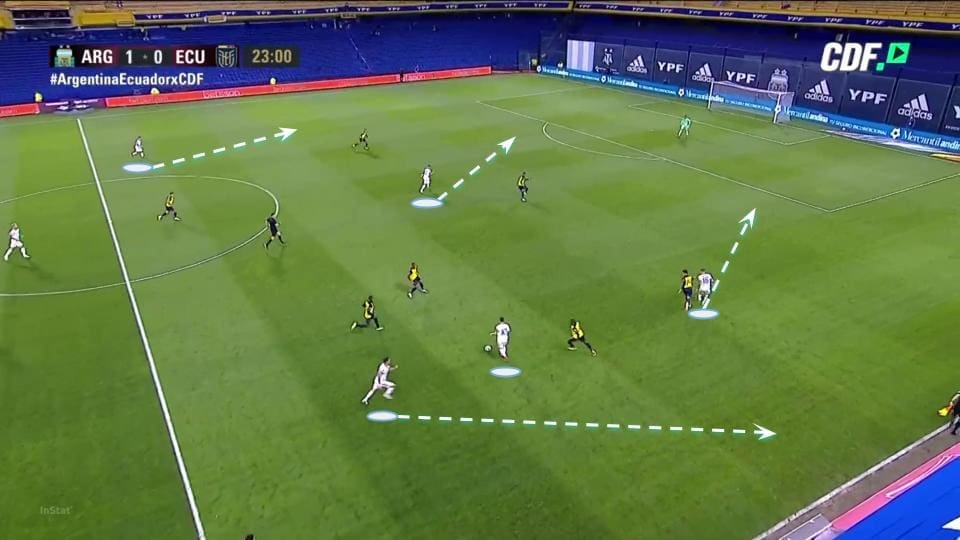
When Argentina can’t find a pass right after recovering the ball, their transitions tend to be slow and they lose the opportunity to create danger. They aren’t the quickest team to break pressing lines and can struggle to find spaces to play forward if they don’t do it when there are more spaces and the rival isn’t organized.
FORWARDS
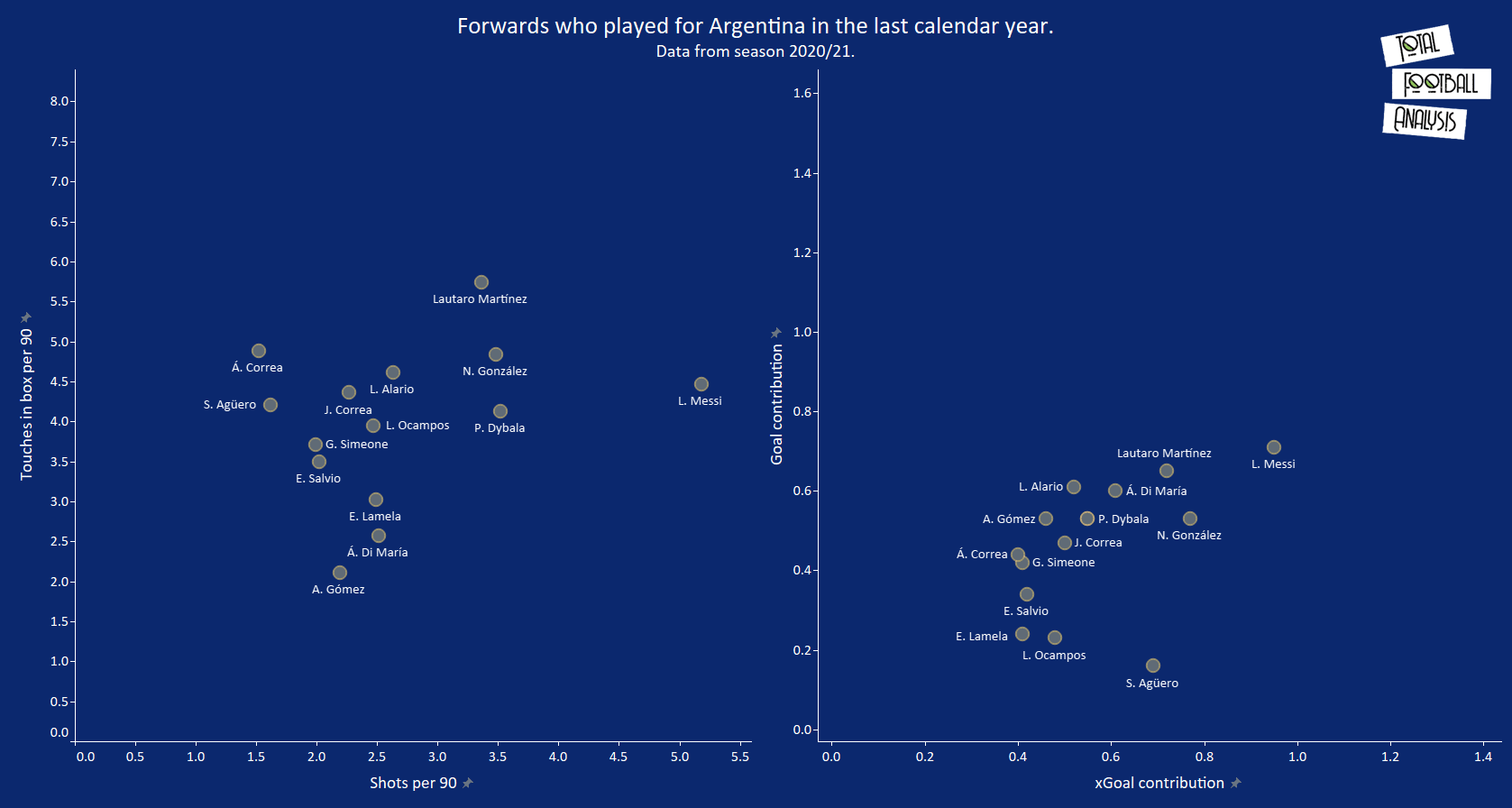
Argentina has a very powerful attacking line. As expected, Messi leads the way in shots, expected goal contributions and goal contributions per 90 so we’ll be looking at the rest of the players to see which two could be the best to play with the Barcelona star.
In the striker position, Lautaro Martínez is the expected starter and the stats support that decision. He’s by some distance the player with the most touches in the box per 90 and has the second-highest goal contributions just behind Messi. With 18 goals and 10 assists this season, he has grown into a top striker and has the challenge of forming a lethal partnership with Messi.
Alongside Messi and Lautaro, there should be a balanced player capable of creating and scoring. Statistically, Nico González looks like a fantastic option, with the second-highest expected goal contributions among Argentinian forwards and with a good presence in the box. However, he’s usually played in the left-back position in the national team and has struggled with injuries late in the season so he’s not expected to be a starter in the tournament.
The next best choice is Ángel Di María. Despite playing in a deeper position, he’s close to Lautaro Martínez and Lucas Alario in goal contributions per 90. His relatively low touches in the box per 90 show he’s playing more in the second line and would fit very well in a front three with Lautaro and Messi. His ideal position is on the right-wing but he has plenty of experience playing on the left and wouldn’t have any problem adapting.
The most affected by Messi’s presence is Paulo Dybala. The Juventus’ forward wouldn’t adapt well to playing on the left or as the lone striker so he doesn’t really have space in the starting XI. However, he’s someone who could contribute with both goals and assists, creating from the second line and also shooting very often. If Argentina needs to break a low block or score goals, he will be an excellent option from the bench.
MIDFIELDERS
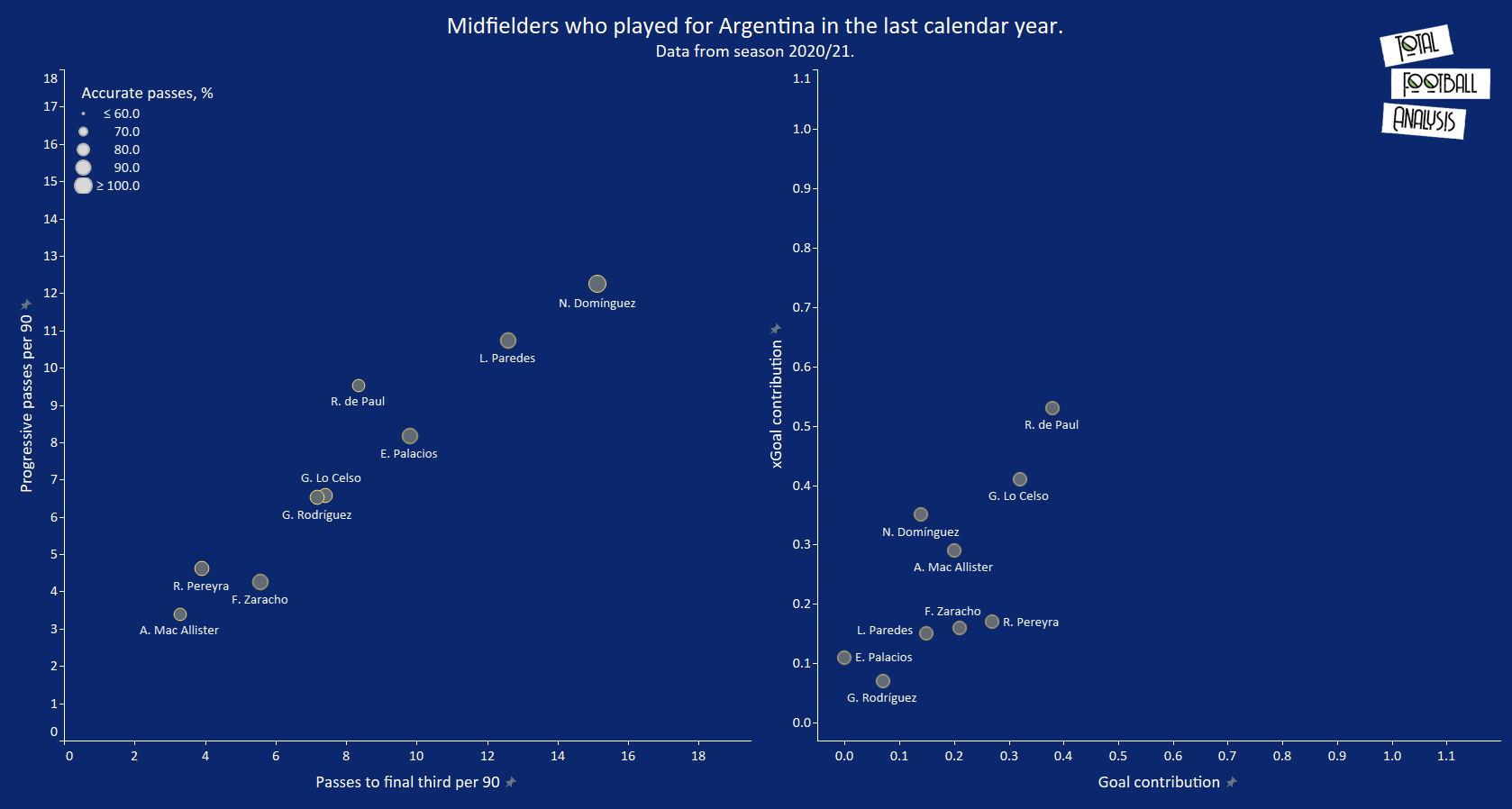
Our expected midfield trio of Paredes, Lo Celso and De Paul looks very balanced on stats. Paredes is excellent at progressing the ball and getting it into the final third. His deep positioning and quality on the ball mean he has a wide range of options to progress and makes good decisions too.
In front of him, we expect to see two much more attacking options. De Paul and Lo Celso are first and second respectively both in goal contributions and expected goal contributions per 90. De Paul also looks great at progressing the ball and getting it into the final third, while Lo Celso creates in more advanced positions and isn’t as active at passing the ball forward. They complement each other and their tendency to get into good positions means Messi will have more passing options.
Nico Domínguez also looks very interesting here. In his first season at Bologna, he has the highest passes to final third and progressive passes among Argentinian midfielders. He’s still 22 but already has eight caps to his name and could be a nice option to contribute from the bench. He’s very dynamic, wants to play forward and would fit very well in Argentina’s tactics, especially when the starter players need some rest.
DEFENDERS
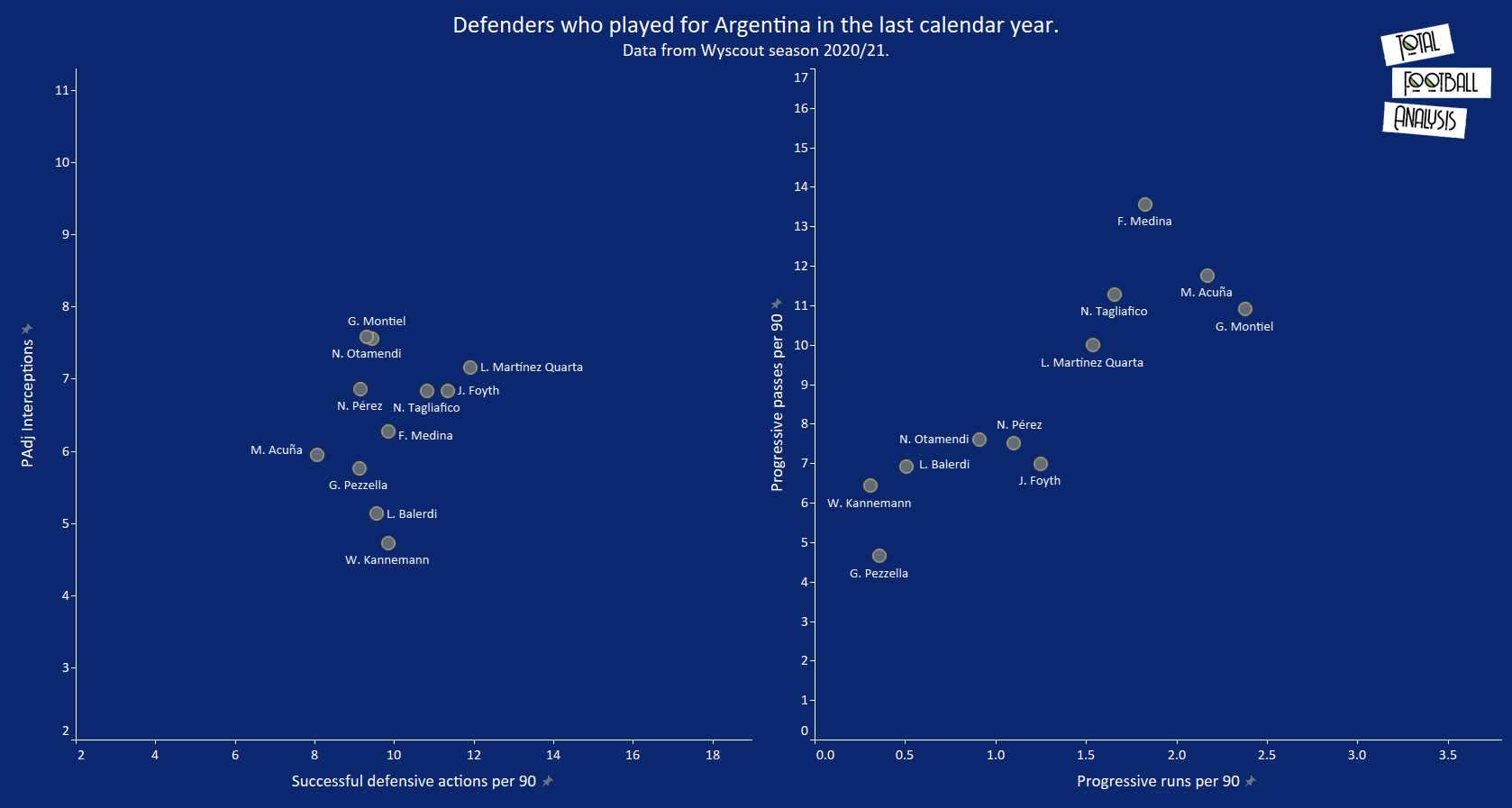
Defensive abilities are difficult to measure with stats so these are difficult positions to decide on based just on that. The tactics of each team and the playing style play a very important role here and very often explain the differences between players.
Starting with the full-backs, we can see why Montiel is the preferred choice. The 24-year-old right-back has the most progressive runs per 90 among Argentinian defenders and is also a great passer from the back. Playing for a dominating team like River Plate, he doesn’t get involved in defensive duties as much as others but he’s still the best in interceptions when we adjust them for possession and ranks ok in successful defensive actions per 90.
On the left-back position, Taglaifico and Acuña both rank well as offensive players. Acuña has more power to run with the ball and is at the same level when playing passes through the lines. However, Tagliafico is more involved in defence so he offers something slightly different. Both are excellent options and Scaloni will have a difficult choice there.
In the middle of the defensive line, the competence will be huge. Lens’ Facundo Medina stands out as a fantastic progressor from the back but at 21 and ranking just averagely in defensive stats, he would be a risky choice.
Martínez Quarta also looks very good both in attack and defence. He’s one of the best ball-progressors but also the player with the most successful defensive actions per 90 and good at interceptions too. However, he has lost his starting position at Fiorentina and doesn’t reach the tournament at his best. His teammate Pezzella, who we’re expecting to start, doesn’t rank especially well in the metrics we’ve selected but has still played more than him at Fiorentina.
Otamendi, the other centre-back who has started in recent games, is very proactive and ranks very well in interceptions. He’s a leader at the back and that could be a big point in his favour even if he’s past his best years.
BEST PERFORMER
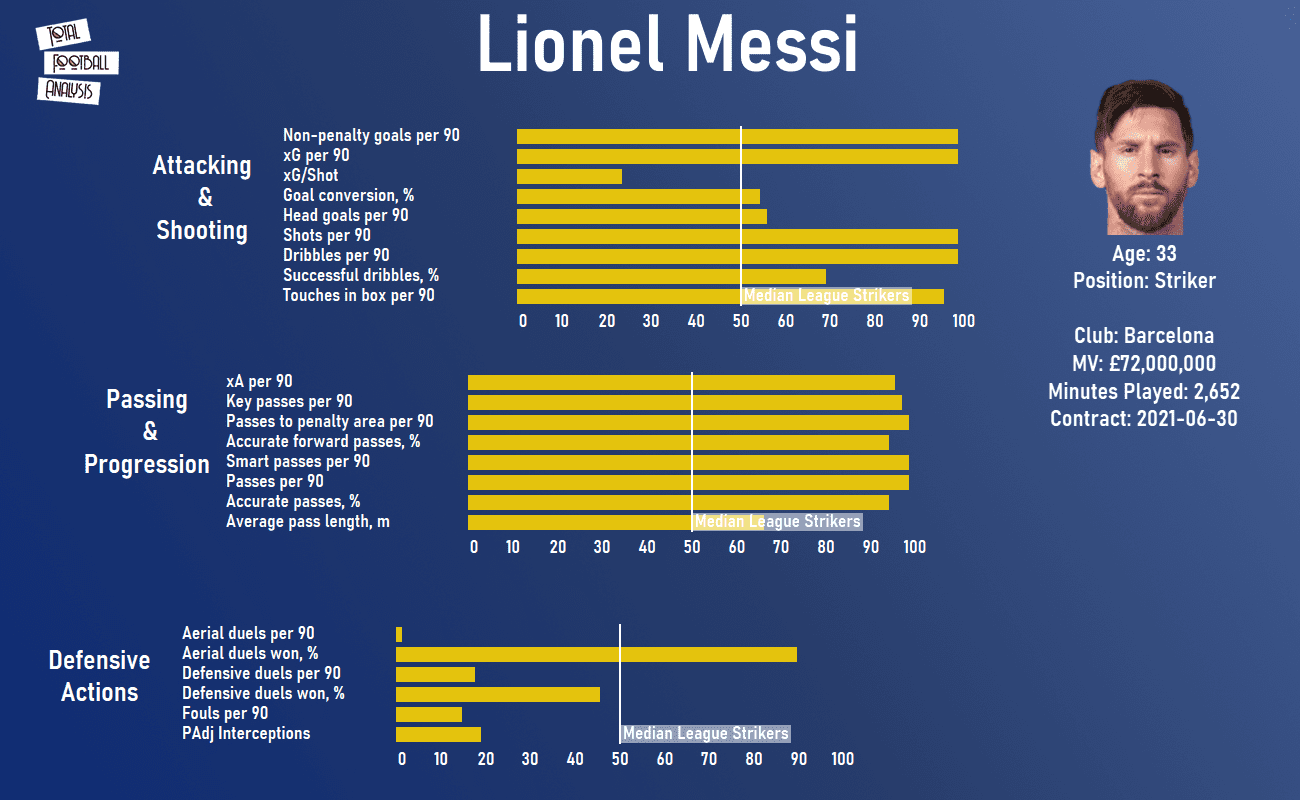
There isn’t much to say about Lionel Messi that hasn’t been said before. Despite having his worst season in more than ten years and playing for a Barcelona side that has been poor in La Liga and the UEFA Champions League, he has still managed to be on top of the goals and assists tables once again.
He’s the best striker in La Liga for non-penalty goals, xG, shoots, dribbles, passes, smart passes and passes to penalty area per 90 and ranks in the top 10% for the rest of the creative passing stats. At 33, Messi has developed into a player capable of creating danger from any part of the pitch, getting into good positions in the box, progressing from midfield and with a vision that’s unmatched in world football.
The season has been difficult for Messi. After wanting to leave Barcelona at the end of the 2019/20 season, he has been surrounded by rumours and negative opinions. The low quality of Barcelona’s current squad, the presidential elections in the middle of the season and another European humiliation have only contributed to his mental fatigue and he’ll need a good rest before the tournament to see it as a fresh start.
Argentina will once again trust their number 10 to win the Copa América, which would be Messi’s first major trophy with his national team. He has played four finals with Argentina (three in the Copa América and one in the World Cup) losing all of them, so at the moment it’s the only flaw in his otherwise perfect CV. At his age, this will be one of his last chances to win silverware for his country and he’ll be obviously motivated and focused to get it.
When he steps onto the pitch, Messi will still be the best player on Earth despite all the noise surrounding him and his future. We can expect him to compete for the MVP award and help Argentina win the Copa América. Doing it at home and the year Diego Armando Maradona passed away would add an extra emotional component to the trophy.
PREDICTIONS FOR THE TOURNAMENT
After some transition years after the 2014 World Cup, Argentina once again has a squad full of footballers playing at the highest level and capable of competing against anyone. With the tournament being held in Argentina, they’ll have the added pressure of being the hosts and favourites but are expected to accept it and compete until the end.
In a tournament as open and tough as the Copa América, it’s difficult to choose one favourite but Argentina is definitely one of them. Hosts and with the best player in the world in their squad, they are expected to beat any rival and raise a much-awaited trophy they haven’t won since 1993.

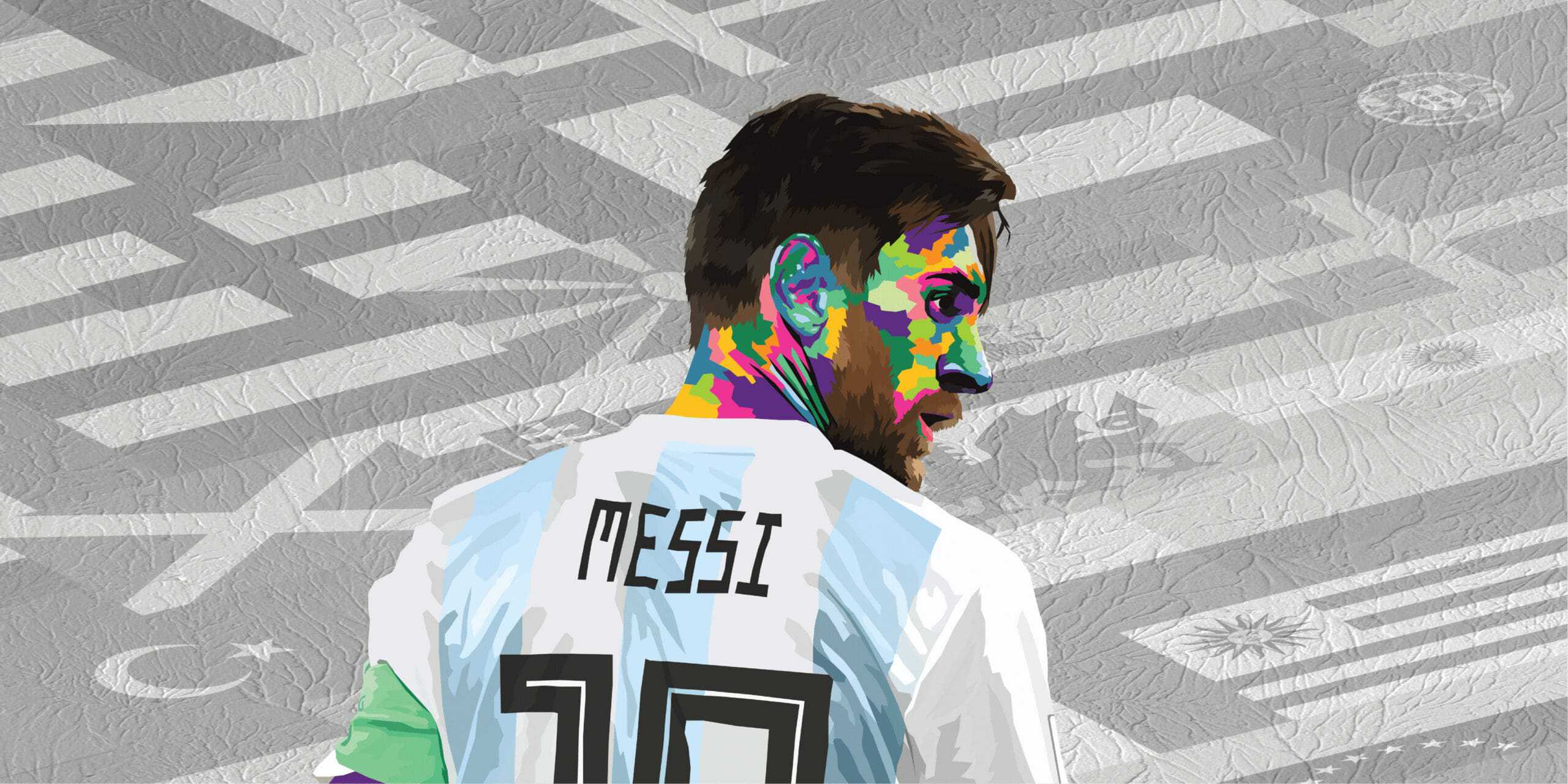



Comments